Ijraset Journal For Research in Applied Science and Engineering Technology
- Home / Ijraset
- On This Page
- Abstract
- Introduction
- Conclusion
- References
- Copyright
Smart Zone-Based Vehicle Speed Retarding System Utilizing Radio Frequency (RF) in Electronic Vehicles
Authors: Subhana Ayesha Siddiqui , P Sreesudha
DOI Link: https://doi.org/10.22214/ijraset.2024.64691
Certificate: View Certificate
Abstract
The proposed system aims in designing an efficient automatic wireless vehicle speed control in low-speed zones using RF communication. The advent of new high-speed technology and the growing computer capacity provided realistic opportunity for new robot controls and realization of new methods of control theory. This technical improvement together with the need for high performance robots created faster, more accurate and more intelligent robots using new robots control devices, new drivers and advanced control algorithms. The proposed method uses RF transmitter and receiver modules for establishing wireless communication, DC motors for the vehicle movement controller. The status of the project will display on LCD display. The controlling device of the whole system is a Microcontroller to which RF receiver module, DC motors are interfaced through a motor driver. Whenever the vehicle enters into a low-speed zone, the data from RF transmitter of low-speed zone will be received by the vehicle system. The microcontroller in the vehicle system automatically slows down the speed to the speed limit of that zone. The microcontroller checks the data with the program embedded in it and performs appropriate actions on the electric motors. The microcontroller is programmed using Embedded C language.
Introduction
I. INTRODUCTION
In today’s fast-moving world, as the rate of accidents is increasing day by day, speed of vehicles should be controlled as much as possible. Most of the accidents occurred in India are results of lack of speed control and violating the road rules. For this reason, different speed limits are put to decrease accidents. Unfortunately, drivers usually do not take these speed limits seriously and ignore them. Road accidents can be prevented by adopting measures such as Traffic management, improving quality of road infrastructure and safer vehicles. To Ensure decline in accidents and to improve road safety, speed control techniques such as speed control in school and hospital zones by using RF transceiver.
In fast moving world’s, accidents are mostly occurring due to breaking the rules of the road and over speeding. The accidents rates are increasing year to year by more vehicles onto ground and heavy traffic. The government has taken to many steps to prevent this kind of things, but it is not enough.
The RF transmitter is placed in the speed limit areas and RF receiver is placed in the system which is placed inside the vehicle. RF transmitter transfers the information about the speed of the zone to the receiver which is interfaced with microcontroller. The current speed will be sensed by the proximity sensor using dc motor that also sends information to controller. The controller compares both speeds, if speed of vehicle is greater than speed limit of the area then message is given to the driver through LCD display to reduce the speed. And if driver does not decrease the speed, the control transfers automatically.
In urban and suburban environments, managing vehicle speeds effectively is essential to reduce accidents, improve traffic flow, and ensure pedestrian safety. Traditional speed control methods, such as speed bumps and traffic signals, often lack the precision and adaptability required to address dynamic traffic conditions. The proposed Smart Zone-Based Vehicle Speed Retarding System leverages RF technology to create a more responsive and adaptable solution. Radio Frequency (RF) technology, particularly Radio Frequency Identification (RFID), has proven to be a reliable and efficient means of communication in various applications, including access control, asset tracking, and inventory management. In the context of vehicular systems, RF technology can be utilized to communicate with vehicles in real-time, enabling the implementation of geofencing and zone-based control mechanisms. By establishing predefined zones with specific speed limits, the system can dynamically adjust vehicle speeds as they enter these zones, ensuring compliance with local traffic regulations and enhancing overall safety.
II. BLOCK DIAGRAM

Fig. 1 Receiver block diagram
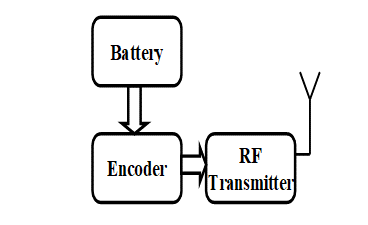
Fig. 2 Transmitter block diagram
Using a 12 volts 1 amp battery, a PIC microcontroller and a RF transmitter and receiver and also using a MOSFET board to control four motors and 16 by 2 LCD display to display the different zones. In the battery, using 4-volt 1 amp 3 batteries, that are connected in a series manner which in turn will become 12 volts with 1 amp battery connected in the series where current will be same, that is connected to the PIC microcontroller using 7805 voltage regulators, it takes the 12 volts input and it will give the 5 volts of output, that 5 volts of output will be given to this microcontroller board.
At the same time microcontroller board will equally divide the 5 volts power supply to RF receiver and the MOSFET board and also give the 5 volts to the LCD display. Giving the 12 volts power supply to the MOSFET board, so based on the signals, it’s also controlling the DC motors, whether the high speed and low speed using this microcontroller, so here C2 pin is connected with the MOSFET board, based on the signal received it will be controlled and here use of two transmitters, is done for transmitting the radio frequency signals.
A step-down transformer and the charging circuit is used to charge the battery, so here the power connection given with 230 volts power supply from this power cable and it will be stepped down up to 12 volts 1 amp, that will be converted into AC to DC using rectifier, giving the AC voltage 12 volts and it will be converted to a 12 volts DC, that 12 volts DC will be given to 12 volts DC battery. Maximum of 6 to 7 hours charging is required for longer use.
III. IMPLEMENTATION
To implement a Smart Zone-Based Vehicle Speed Retarding System utilizing Radio Frequency (RF) for Electronic Vehicles (EVs), need to design a system that can automatically adjust the speed of vehicles when they enter specific zones. This can be particularly useful in areas such as school zones, construction sites, or residential areas where speed control is crucial for safety.
A. Design Considerations
- RF Communication: Choose a suitable RF frequency and protocol for reliable communication.
- Transmitter and Receiver: Design or select appropriate RF transmitters and receivers.
- Integration with Vehicle Control System: Ensure that the vehicle's control system can interface with the RF receiver to modify the speed.
- Power Management: Ensure that the RF system's power requirements are compatible with the vehicle's power system.
- Safety and Security: Implement measures to ensure the system is secure and cannot be easily tampered with.
B. Implementation Steps
1) RF Transmitter Setup
-
- Select an appropriate RF frequency (e.g., 2.4 GHz).
- Design or purchase an RF transmitter module.
- Program the transmitter to emit a signal with the desired speed limit data when a vehicle enters the zone.
2) RF Receiver Integration in EVs
- Equip the EV with an RF receiver capable of decoding the transmitter's signals.
- Interface the RF receiver with the EV's electronic control unit (ECU).
3) Speed Control Mechanism
-
- Develop a software module in the ECU that reads the speed limit data from the RF receiver.
- Implement logic to reduce the vehicle's speed to the transmitted limit when the signal is received.
- Include a failsafe mechanism to revert to normal operation if the signal is lost or invalid.
4) Testing and Calibration
-
- Conduct tests in a controlled environment to ensure reliable communication between the transmitter and receiver.
- Calibrate the speed control mechanism to ensure it responds correctly to the received signals.
5) Field Trials
-
- Deploy the system in a real-world scenario, such as a school zone or residential area.
- Collect data on system performance and vehicle compliance with speed limits.
When the vehicle enters in the normal area its speed does not decrease and it goes normally means there is a no action is required. Whenever it enters, the transmitter module just sends an information to the receiver that contains how much speed a vehicle can go inside the speed limited region. The signal is basically analog in nature that will be converted into digital so only the microcontroller able to process the signal. figure 3: Image of the transmitter part hardware (hospital zone and school zone)
The microcontroller compares both the signals, in this there are two cases:
- If speed of vehicle is less than the speed limit of road, then no action required, vehicle goes normally.
- If speed of vehicle is greater than the speed limit of the road zone, then the actual speed of vehicle and speed of that zone is displayed on LCD display also the message is given to the driver to reduce the speed below the limit.
- If speed change is occurred within minimum time period, then it is accepted. But if driver does not reduce the speed below speed limit of that zone, then our system will work automatically means the vehicle can go with speed limit of that zone.
IV. RESULTS
The Proposed system is basically for controlling the vehicle remotely to demonstrate Smart Zone-Based Vehicle Speed Retarding System Utilizing Radio Frequency (RF) in Electronic Vehicles, was designed such that to control the speed of a vehicle based on zones using RF technology.


Fig. 3 Image of the transmitter part hardware (hospital zone and school zone)
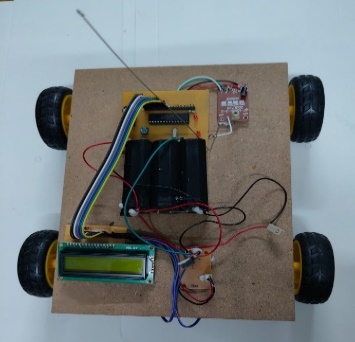
Fig. 4 Image of the receiver part hardware
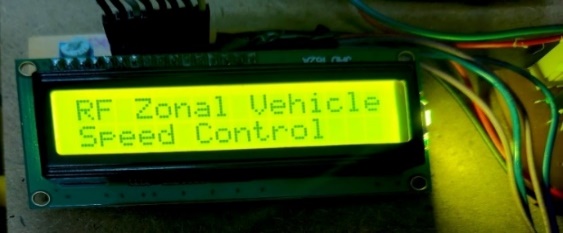
Fig. 5 Image of the LCD Display
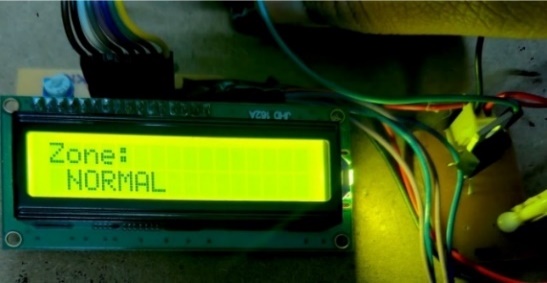
Fig. 6 Image of the LCD display for NORMAL ZONE
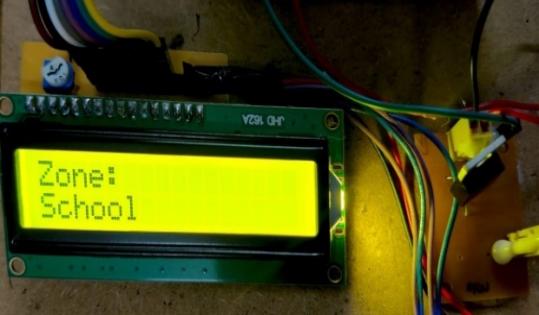
Fig. 7 Image of the LCD display for SCHOOL ZONE
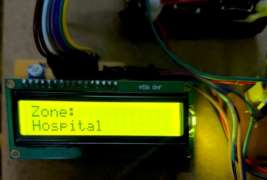
Fig. 8 Image of the LCD display for HOSPITAL ZONE
The figures 6 to 8 showing various zones. The primary goal of the motor rotates at a regular speed; the output of the LCD Display is “ZONE NORMAL”, When RF receiver sense the RF signal send by the transmitter, the output of the LCD Display is “ZONE HOSPITAL” and also the output of the LCD Display is “ZONE SCHOOL” After Detected the Restricted Zones, the motor speed is reduced to a range of 20% to 50% of the actual speed.
In real time these systems fall within specific ranges allocated for industrial, scientific, and medical (ISM) applications, as well as other dedicated short-range communication (DSRC) bands. These frequencies ensure reliable communication and minimal interference
- 2.4 GHz ISM Band: This is one of the most widely used frequency bands for short-range wireless communication. It covers 100 meters area; this 2.4 GHz comes under ultra-high frequency.
- 5.8 GHz ISM Band: This band is also used for short-range communication and provides higher data rates and less interference compared to the 2.4 GHz band. It’s often used for applications requiring higher bandwidth.
- DSRC (Dedicated Short-Range Communications) Band: In many regions, the 5.9 GHz band is allocated for DSRC, which is specifically designed for automotive applications, including vehicle-to-infrastructure (V2I) and vehicle-to-vehicle (V2V) communications. DSRC supports low-latency communication, which is crucial for real-time speed control and safety application.
Conclusion
Implementing a Smart Zone-Based Vehicle Speed Retarding System utilizing RF technology offers a promising approach to enhancing road safety in critical areas such as school zones, construction sites, and residential neighborhoods. By integrating RF communication with the vehicle\'s electronic control systems, this solution enables automatic speed regulation when vehicles enter predefined zones. The system ensures higher compliance with speed limits, potentially reducing accidents and improving pedestrian safety. Key design considerations include selecting appropriate RF frequencies and protocols, integrating reliable transmitters and receivers, and ensuring secure communication. Thorough testing and calibration are essential to ensure reliable performance in real-world conditions. This innovative approach to speed control not only enhances safety but also provides valuable data on traffic patterns, contributing to smarter traffic management systems. Overall, the deployment of RF-based speed retarding systems in electronic vehicles represents a significant advancement in the quest for safer and more efficient roadways. The future scope of the Smart Zone-Based Vehicle Speed Retarding System utilizing RF technology is vast and promising. As the adoption of electronic vehicles continues to grow, integrating advanced safety features like RF-based speed control will become increasingly important. Future enhancements could include incorporating GPS and advanced sensor technologies to create more dynamic and adaptable speed control zones. This would allow for real-time adjustments based on traffic conditions, weather and other environmental factors. Additionally, integration with smart city infrastructure could enable centralized management of speed zones, enhancing overall urban mobility and safety.
References
[1] John and P. R. Nishanth, “Real time embedded system for accident prevention”, 2017 International conference of Electronics, Communication and Aerospace Technology (ICECA) [2] D. Selvathi, P. Pavithra and T. Preethi, \"Intelligent transportation system for accident prevention and detection”, (2017) International Conference on Intelligent Computing and Control Systems (ICICCS) [3] Chen, Z., & Fan, Z. (2016). “RF Communication System for Vehicle-to-Infrastructure and Vehicle-to-Vehicle Applications”, IEEE Communications Magazine, 54(12), 90-96. [4] Muhammad H. Rashid, “Power Electronics Circuits Devices and Applications”, Prentice Hall, publication New Delhi 2008. [5] Shruti Shrivastava, Jageshwar Rawat, Amit Agrawal, Controlling DC Motor Using Microcontroller (PIC16F72) With PWM, International Journal of Engineering Research [6] Park, J., & Kim, Y. (2020). Technological Innovations in Electric Vehicles: A Review, Journal of Power Sources, 478, 228706. [7] Agarwal, S., & Lang, D. (2018). Wireless Communications & Networks: Concepts and Practice. Wiley. [8] Zhang, 8. Y., & Chen, X. (2020). Smart Transportation Systems: Technologies and Applications, IEEE Transactions on Intelligent Transportation Systems. [9] Li, J., & Wang, H. (2019). Design and Implementation of a Radio Frequency-Based Speed Control System for Smart Vehicles, Proceedings of the 2019 IEEE International Conference on Vehicular Electronics and Safety. [10] Kumar, S., & Patel, R. (2021). Integrating RF Technology in Electronic Vehicles for Enhanced Speed Management in Urban Areas, Proceedings of the 2021 International Conference on Smart Cities and Urban Planning. [11] K.Dewangan, N Chakraborty, S Shukla, V Yadu, PWM Based Automatic Closed loop Speed Control Of DC Motor, Iternational Journal of Engineering Trends and Technology. [12] Xu, Guoqing & Li, Weimin & Xu, Kun & Song, Zhibin. (2011). An Intelligent Regenerative Braking Strategy for Electric Vehicles. Energies. [13] Y. Yao, Y. Yao, Y. Liu and Z. Peng, “The application of RF technology in industry field”, 2010 IEEE International Conference on Software Engineering and Service Sciences, 2010.
Copyright
Copyright © 2024 Subhana Ayesha Siddiqui , P Sreesudha. This is an open access article distributed under the Creative Commons Attribution License, which permits unrestricted use, distribution, and reproduction in any medium, provided the original work is properly cited.

Download Paper
Paper Id : IJRASET64691
Publish Date : 2024-10-19
ISSN : 2321-9653
Publisher Name : IJRASET
DOI Link : Click Here
 Submit Paper Online
Submit Paper Online

